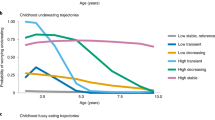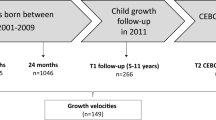Abstract
Objective:
To discover whether eating behaviour traits show continuity and stability over childhood.
Subjects/Methods:
Mothers of 428 twin children from the Twins Early Development Study participated in a study of eating and weight in 1999 when the children were 4 years old. Families were contacted again in 2006 when the children were aged 10 years, with complete data on 322 children; a response rate of 75%. At both times, mothers completed the Child Eating Behaviour Questionnaire (CEBQ) for each child. Continuity was assessed with correlations between scores at the two time points, and stability by changes in mean scores over time.
Results:
For all CEBQ subscales, correlations between the two time points were highly significant (P-values <0.001). For satiety responsiveness, slowness in eating, food responsiveness, enjoyment of food, emotional overeating and food fussiness, correlations ranged from r=0.44 to 0.55, with lower continuity for emotional undereating (r=0.29). Over time, satiety responsiveness, slowness in eating, food fussiness, and emotional undereating decreased, while food responsiveness, enjoyment of food and emotional overeating increased.
Conclusions:
Eating behaviours, including those associated with a tendency to overeat, emerge early in the developmental pathway and show levels of individual continuity comparable to stable personality traits. Appetitive traits related to higher satiety tended to decrease with maturation, while those associated with food responsiveness tended to increase. This pattern is consistent with strong tracking of body mass index alongside a progressive increase in the risk of obesity.
This is a preview of subscription content, access via your institution
Access options
Subscribe to this journal
Receive 12 print issues and online access
$259.00 per year
only $21.58 per issue
Buy this article
- Purchase on Springer Link
- Instant access to full article PDF
Prices may be subject to local taxes which are calculated during checkout
Similar content being viewed by others
References
Asendorpf JB (1992). A Brunswikean approach to trait continuity: application to shyness. J Pers 60, 53–77.
Barkeling B, Ekman S, Rossner S (1992). Eating behaviour in obese and normal weight 11-year-old children. Int J Obes Relat Metab Disord 16, 355–360.
Birch LL, Deysher M (1986). Caloric compensation and sensory specific satiety: evidence for self regulation of food intake by young children. Appetite 7, 323–331.
Braet C, Van Strien T (1997). Assessment of emotional, externally induced and restrained eating behaviour in nine to twelve-year-old obese and non-obese children. Behav Res Ther 35, 863–873.
Caccialanza R, Nicholls D, Cena H, Maccarini L, Rezzani C, Antonioli L et al. (2004). Validation of the Dutch Eating Behaviour Questionnaire parent version (DEBQ-P) in the Italian population: a screening tool to detect differences in eating behaviour among obese, overweight and normal-weight preadolescents. Eur J Clin Nutr 58, 1217–1222.
Carnell S, Wardle J (2007). Measuring behavioural susceptibility to obesity: validation of the child eating behaviour questionnaire. Appetite 48, 104–113.
Cohen J (1992). A power primer. Psychol Bull 112, 155–159.
Cole TJ (2002). A chart to link child centiles of body mass index, weight and height. Eur J Clin Nutr 56, 1194–1199.
Epstein LH, Paluch R, Coleman KJ (1996). Differences in salivation to repeated food cues in obese and nonobese women. Psychosom Med 58, 160–164.
Fisher JO, Birch LL (2002). Eating in the absence of hunger and overweight in girls from 5 to 7 y of age. Am J Clin Nutr 76, 226–231.
Fraley RC, Roberts BW (2005). Patterns of continuity: a dynamic model for conceptualizing the stability of individual differences in psychological constructs across the life course. Psychol Rev 112, 60–74.
Jansen A, Theunissen N, Slechten K, Nederkoorn C, Boon B, Mulkens S et al. (2003). Overweight children overeat after exposure to food cues. Eat Behav 4, 197–209.
Kelder SH, Perry CL, Klepp KI, Lytle LL (1994). Longitudinal tracking of adolescent smoking, physical activity, and food choice behaviors. Am J Public Health 84, 1121–1126.
Lake AA, Mathers JC, Rugg-Gunn AJ, Adamson AJ (2006). Longitudinal change in food habits between adolescence (11–12 years) and adulthood (32–33 years): the ASH30 Study. J Public Health (Oxf) 28, 10–16.
Lien N, Klepp KI (1999). Consumption of fruit and vegetables in a teenage cohort—observed changes. Tidsskr Nor Laegeforen 119, 2327–2330.
Marchi M, Cohen P (1990). Early childhood eating behaviors and adolescent eating disorders. J Am Acad Child Adolesc Psychiatry 29, 112–117.
Moore LL, Singer MR, Bradlee ML, Djousse L, Proctor MH, Cupples LA et al. (2005). Intake of fruits, vegetables, and dairy products in early childhood and subsequent blood pressure change. Epidemiology 16, 4–11.
Oliver BR, Plomin R (2007). Twins Early Development Study (TEDS): a multivariate, longitudinal genetic investigation of language, cognition and behaviour problems from childhood through adolescence. Twin Res Hum Genet 10, 96–105.
Roberts BW, DelVecchio WF (2000). The rank-order consistency of personality traits from childhood to old age: a quantitative review of longitudinal studies. Psychol Bull 126, 3–25.
Rolls BJ (1986). Sensory-specific satiety. Nutr Rev 44, 93–101.
Serdula MK, Ivery D, Coates RJ, Freedman DS, Williamson DF, Byers T (1993). Do obese children become obese adults? A review of the literature. Prev Med 22, 167–177.
Shunk JA, Birch LL (2004). Validity of dietary restraint among 5- to 9-year old girls. Appetite 42, 241–247.
Skinner JD, Carruth BR, Wendy B, Ziegler PJ (2002). Children's food preferences: a longitudinal analysis. J Am Diet Assoc 102, 1638–1647.
Steinberger J, Moran A, Hong CP, Jacobs Jr DR, Sinaiko AR (2001). Adiposity in childhood predicts obesity and insulin resistance in young adulthood. J Pediatr 138, 469–473.
Stunkard AJ, Berkowitz RI, Stallings VA, Schoeller DA (1999). Energy intake, not energy output, is a determinant of body size in infants. Am J Clin Nutr 69, 524–530.
Stunkard AJ, Messick S (1985). The three-factor eating questionnaire to measure dietary restraint, disinhibition and hunger. J Psychosom Res 29, 71–83.
Van Strien T, Frijters JE, Roosen RG, Knuiman-Hijl WJ, Defares PB (1985). Eating behavior, personality traits and body mass in women. Addict Behav 10, 333–343.
Van Strien T, Frijters JER, Bergers GPA, Defares PB (1986). Dutch eating behaviour questionnaire for assessment of restrained, emotional and external eating behaviour. Int J Eat Disord 5, 295–315.
Wang Y, Ge K, Popkin BM (2000). Tracking of body mass index from childhood to adolescence: a 6-y follow-up study in China. Am J Clin Nutr 72, 1018–1024.
Wardle J (2006). Eating behaviour in obesity. In: Shepherd R and Raats M (eds). The Psychology of Food Choices. CABI: UK, pp. 375–388.
Wardle J (2007). Eating behaviour and obesity. Obes Rev 8 (Suppl 1), S73–S75.
Wardle J, Guthrie C, Sanderson S, Birch L, Plomin R (2001a). Food and activity preferences in children of lean and obese parents. Int J Obes Relat Metab Disord 25, 971–977.
Wardle J, Guthrie CA, Sanderson S, Rapoport L (2001b). Development of the Children's Eating Behaviour Questionnaire. J Child Psychol Psychiatry 42, 963–970.
Wardle J, McCaffrey K, Nadel M, Atkin W (2004). Socioeconomic differences in cancer screening participation: comparing cognitive and psychosocial explanations. Soc Sci Med 59, 249–261.
Whitaker RC, Wright JA, Pepe MS, Seidel KD, Dietz WH (1997). Predicting obesity in young adulthood from childhood and parental obesity. N Engl J Med 337, 869–873.
Wright C, Birks E (2000). Risk factors for failure to thrive: a population-based survey. Child Care Health Dev 26, 5–16.
Zive MM, Berry CC, Sallis JF, Frank GC, Nader PR (2002). Tracking dietary intake in white and Mexican-American children from age 4 to 12 years. J Am Diet Assoc 102, 683–689.
Acknowledgements
This research was funded by the Biotechnology and Biological Sciences Research Council.
Author information
Authors and Affiliations
Corresponding author
Additional information
Contributors: JW had the idea for the study and obtained funding. JA and CS carried out the home visits. JA, CHMvJ and CS participated in analysis of the data. All authors took part in the interpretation of results and drafting the manuscript, and approved the final version of the manuscript.
Rights and permissions
About this article
Cite this article
Ashcroft, J., Semmler, C., Carnell, S. et al. Continuity and stability of eating behaviour traits in children. Eur J Clin Nutr 62, 985–990 (2008). https://doi.org/10.1038/sj.ejcn.1602855
Received:
Revised:
Accepted:
Published:
Issue Date:
DOI: https://doi.org/10.1038/sj.ejcn.1602855
Keywords
This article is cited by
-
Stability of child appetitive traits and association with diet quality at 5 years and 9–11 years old: Findings from the ROLO longitudinal birth cohort study
European Journal of Clinical Nutrition (2024)
-
A prediction model for childhood obesity risk using the machine learning method: a panel study on Korean children
Scientific Reports (2023)
-
Parental feeding practices as potential moderating or mediating factors in the associations between children’s early and later growth
International Journal of Obesity (2023)
-
Associations of appetitive traits with growth velocities from infancy to childhood
Scientific Reports (2023)
-
The relationship of parenting style and eating behavior in preschool children
BMC Psychology (2022)



